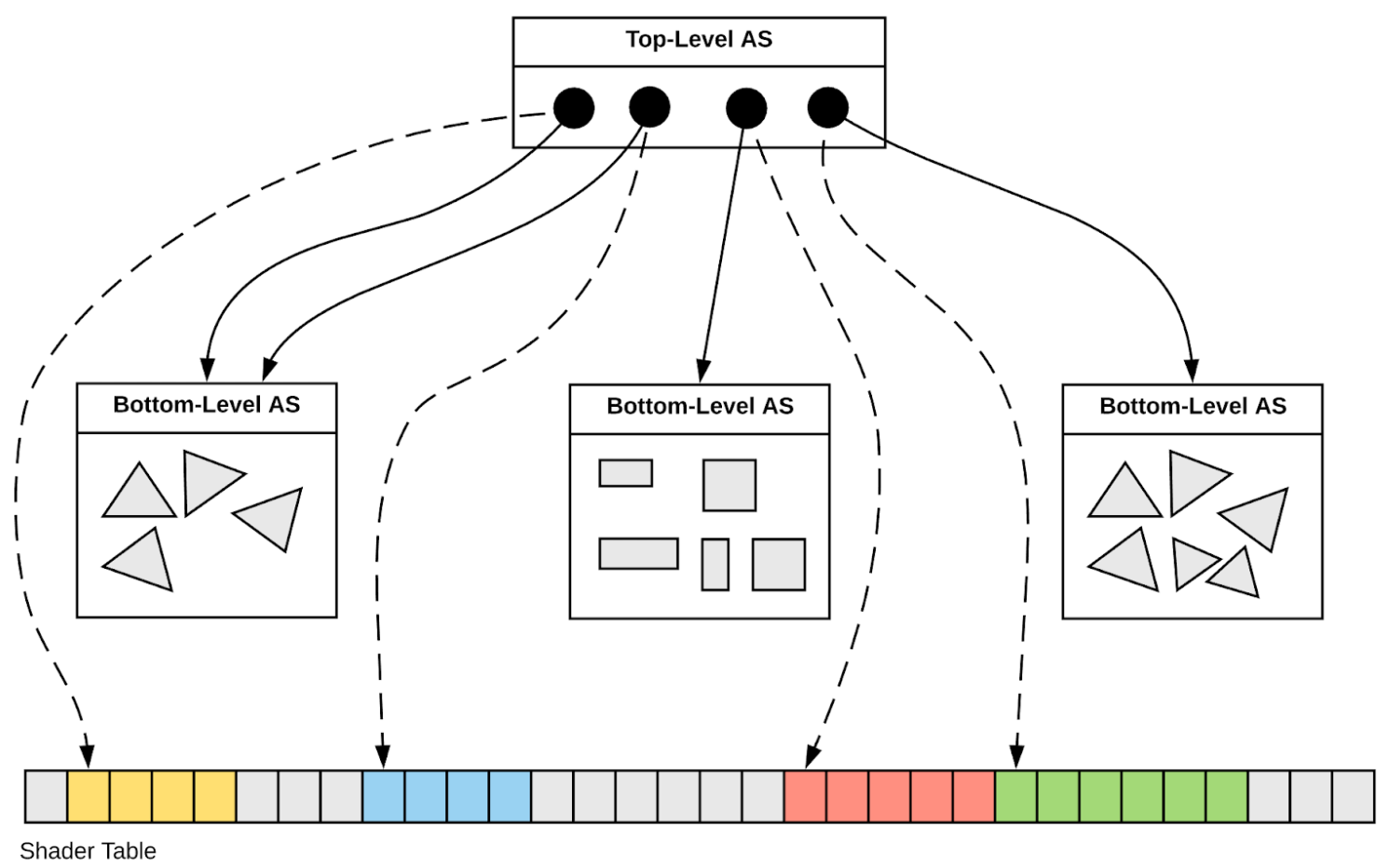Opticks : Innovation in Optical Photon Simulation
Opticks : Innovation in Optical Photon Simulation via
state-of-the-art GPU Ray Tracing from NVIDIA® OptiX™
Open source, https://bitbucket.org/simoncblyth/opticks
Simon C Blyth, IHEP, CAS — Jan 2022, Hong Kong Workshop: Innovation in HEP Detectors & Computing
JUNO Optical Photon Simulation Problem...
Huge CPU Memory+Time Expense
- JUNO Muon Simulation Bottleneck
- ~99% CPU time, memory constraints
- Ray-Geometry intersection Dominates
- simulation is not alone in this problem...
- Optical photons : naturally parallel, simple :
- produced by Cherenkov+Scintillation
- yield only Photomultiplier hits
Optical Photon Simulation ≈ Ray Traced Image Rendering
Not a Photo, a Calculation
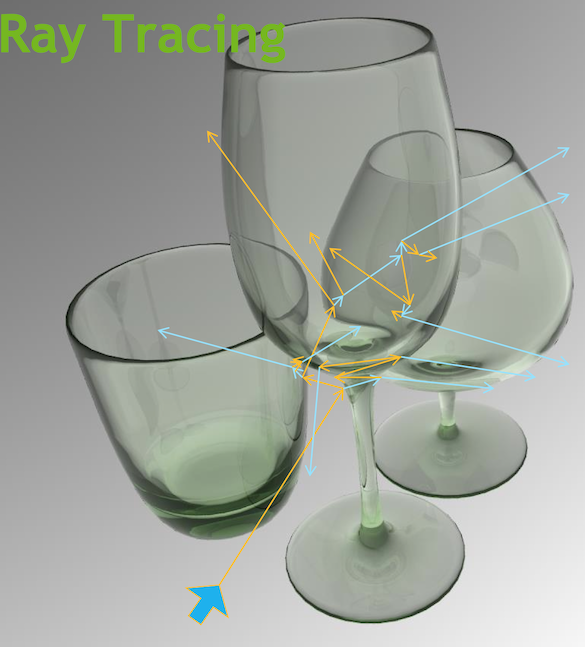
Much in common : geometry, light sources, optical physics
- simulation : photon parameters at PMT detectors
- rendering : pixel values at image plane
- both limited by ray geometry intersection, aka ray tracing
Many Applications of ray tracing :
- advertising, design, architecture, films, games,...
- -> huge efforts to improve hw+sw over 30 yrs
Ray-tracing vs Rasterization
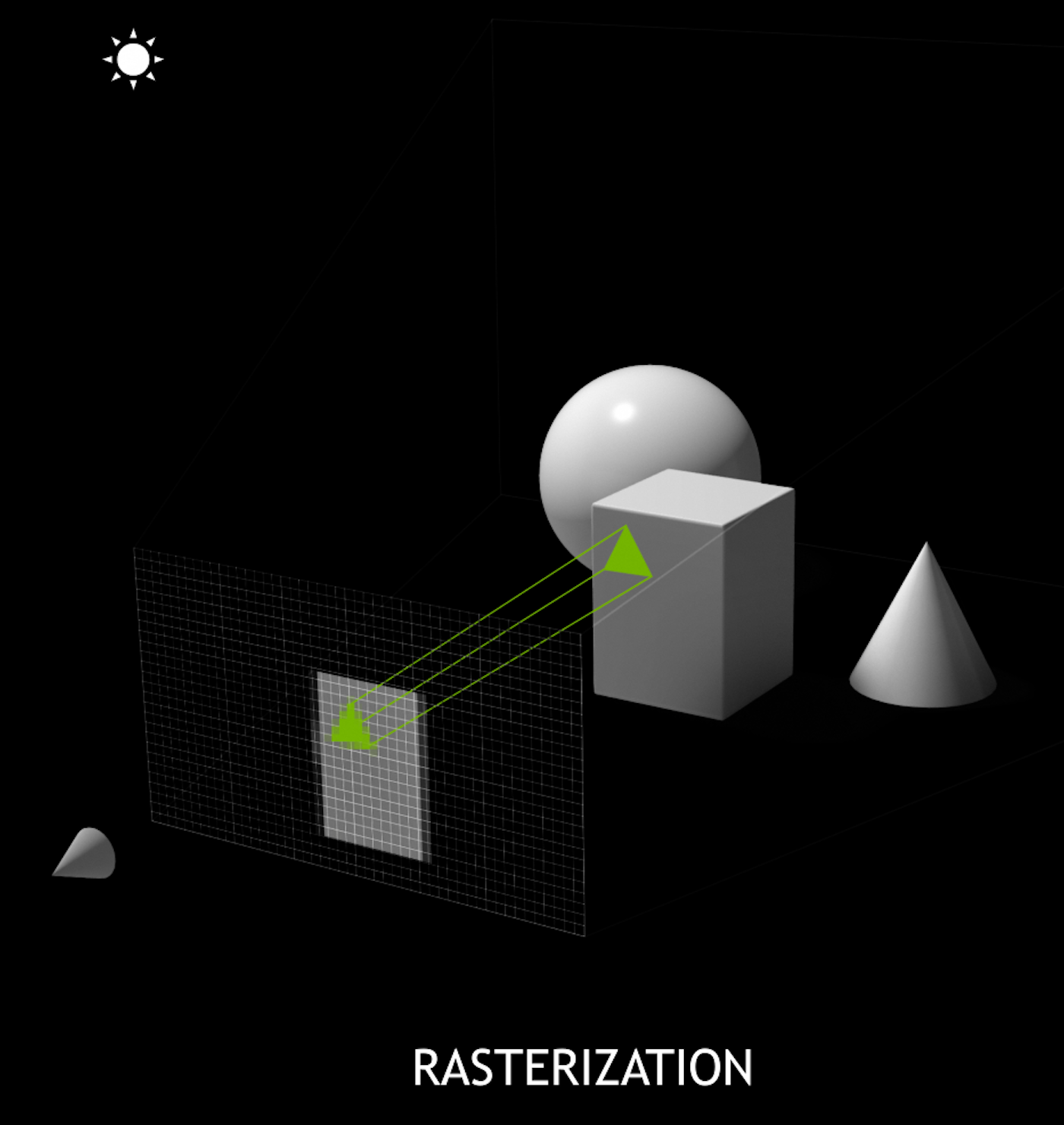
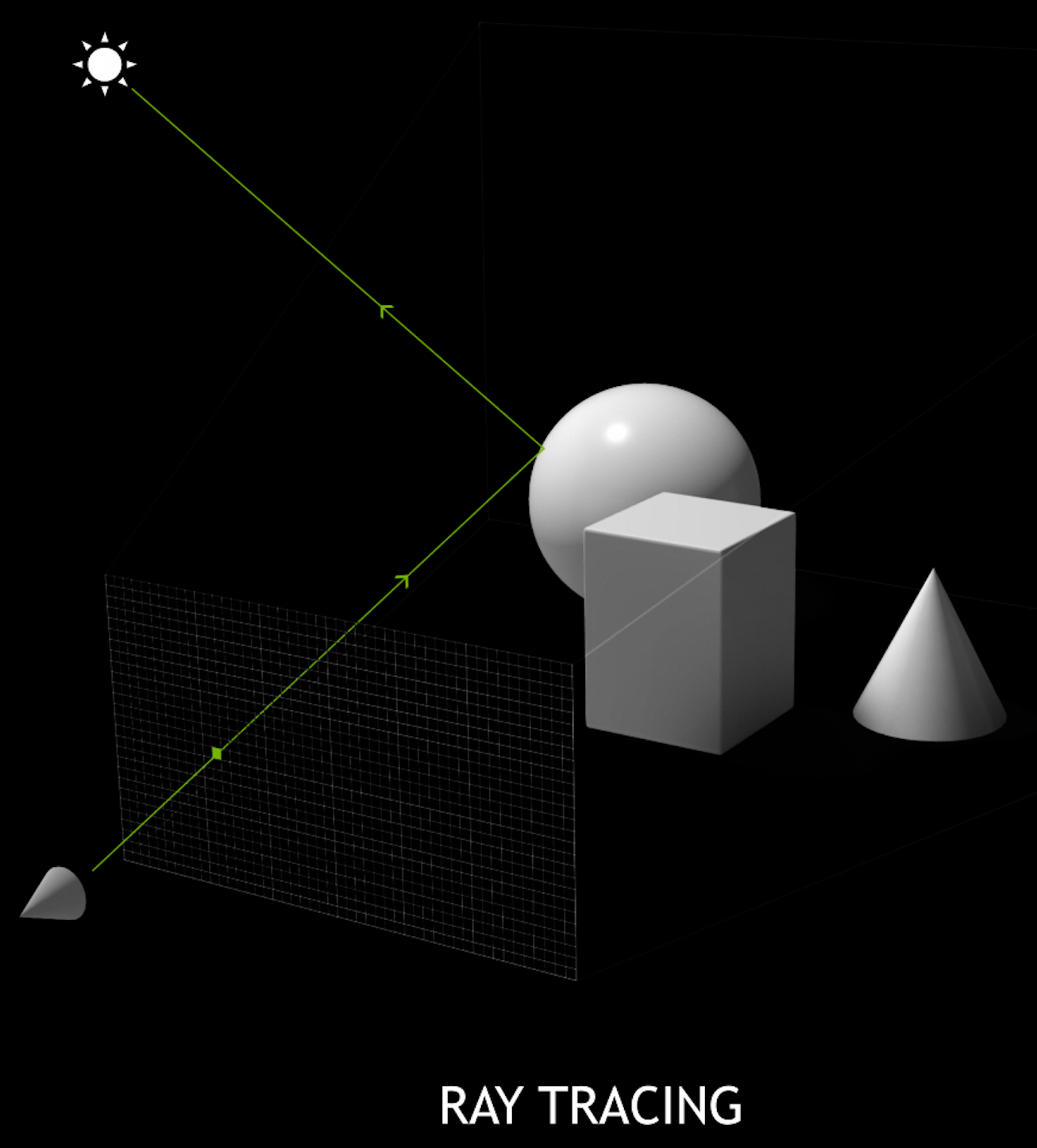
Path Tracing in Production 1
Path Tracing in Production 2
Monte Carlo Path Tracing
Path Tracing is built on top of Ray Tracing
- ubiquitous rendering technique
- random sampling (Monte Carlo method)
- numerical solution of "The Rendering Eqn."
Movies ≈ monte carlo optical photon simulations
The Rendering Equation 1
The Rendering Equation 2
The Rendering Equation 3
Sum over increasing "bounces"
- emission : direct from light source
- direct illumination
- one-bounce indirect illumination
- two-bounce indirect illumination
Top row : individual terms, Bottom row : cumulative
improving realism as more bounces included
Samples per Pixel 1
Samples per Pixel 2
Monte Carlo Path Tracing
- fantastically general technique
- any geometry
- any lighting/surface effect
- BUT noisy : slow 1/sqrt(N) convergence
- need many samples per pixel
- every pixel needing several "bounces"
=> Limited by ray tracing performance
Optical Simulation : Computer Graphics vs Physics
| CG Rendering "Simulation" | Particle Physics Simulation |
|---|---|
| simulates: image formation, vision | simulates photons: generation, propagation, detection |
| (red, green, blue) | wavelength range eg 400-700 nm |
| ignore polarization | polarization vector propagated throughout |
| participating media: clouds,fog,fire [1] | bulk scattering: Rayleigh, MIE |
| human exposure times | nanosecond time scales |
| equilibrium assumption | transient phenomena |
| ignores light speed, time | arrival time crucial, speed of light : 30 cm/ns |
- handling of time is the crucial difference
Despite differences many techniques+hardware+software directly applicable to physics eg:
- GPU accelerated ray tracing (NVIDIA OptiX)
- GPU accelerated property interpolation via textures (NVIDIA CUDA)
- GPU acceleration structures (NVIDIA BVH)
Potentially Useful CG techniques for "billion photon simulations"
- irradiance caching, photon mapping, progressive photon mapping
[1] search for: "Volumetric Rendering Equation"
SIGGRAPH_2018_Announcing_Worlds_First_Ray_Tracing_GPU 2
| 10 Giga Rays/s |
2018 : Leap in Ray Tracing speed
NVIDIA Quadro RTX GPU
- ray trace dedicated GPU hardware
- "World's first ray tracing GPU.."
if: 10 rays per photon => 1 billion photons/sec
TURING BUILT FOR RTX 2
Offload Ray Trace to Dedicated HW
- RT core : BVH traversal + ray tri. intersection
- frees up general purpose SM
SM : Streaming Multiprocessor
BVH : Bounding Volume Hierarchy
Project Sol
2018: NVIDIA RTX 2080Ti (Turing)
"Project Sol" : NVIDIA RTX Demo
real-time cinematic raytracing on single GPU
- now possible due to NVIDIA RTX
Ampere : 2nd Generation RTX
- NVIDIA Ampere (2020):
- "...triple double over Turing (2018, 10 GigaRays/s)..."
- RT Core : ray trace dedicated GPU hardware
- NVIDIA GeForce RTX 3090
- 10,496 CUDA Cores, 28GB VRAM, USD 1499
- ray trace performance continues rapid improvement
NVIDIA Marbles At Night RTX Demo
GTC 2020, NVIDIA Marbles at Night RTX Demo
NVIDIA Marbles At Night RTX Demo 2
GTC 2020, NVIDIA Marbles at Night RTX Demo
Realtime RTX render, 1 Ampere GPU
https://www.youtube.com/watch?v=NgcYLIvlp_k
- playable demo : guide marbles thru geometry
- purely path-traced, no rasterization, no baking
- hundreds of dynamic ray-traced lights
- ~100M polygons
- AI : DLSS + denoising
- 1440p @ 30fps on single Ampere GPU :
NVIDIA GeForce RTX 3090 [USD 1499]
2560*1440 = 3.7M pixels -> x30 -> 110M pixels/s
DLSS : Deep Learning Super Sampling
GPU Ray Tracing (RT) APIs Give Access to NVIDIA RTX
Interfaces over NVIDIA Driver
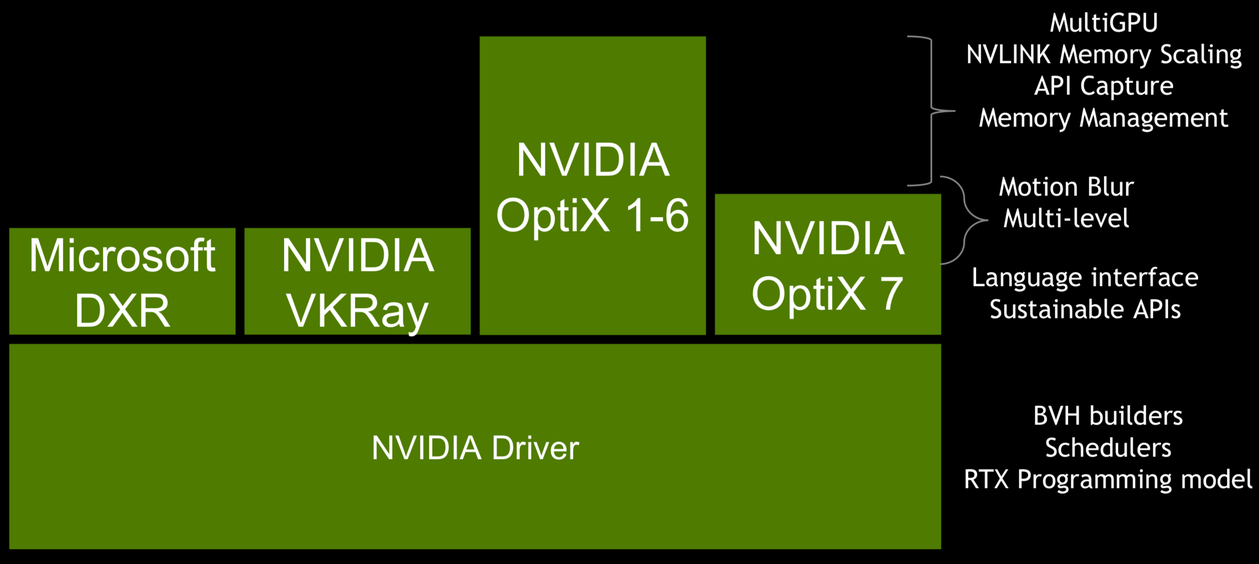
Driver Updates : Independant of Application
- new GPU support
- performance improvements
Three Similar Interfaces over same RTX tech:
NVIDIA OptiX (Linux, Windows) [2009]
- CUDA header only access to Driver functionality
- Most flexible API, OptiX, is used by Opticks
Vulkan RT (Linux, Windows) [final spec 2020]
- cross-vendor cross-platform RT
Microsoft DXR : DirectX 12 Ray Tracing (Windows) [2018]
- enhancing visual quality of realtime games
Metal Ray Tracing API (macOS) [introduced 2020[1]]
- Very different Integrated GPU : Apple Silicon M1 GPU
- BUT: similar API
[1] https://developer.apple.com/videos/play/wwdc2020/10012/
Spatial Index Acceleration Structure
Tree of Bounding Boxes (bbox)
- aims to minimize bbox+primitive intersects
- accelerates ray-geometry intersection
NVIDIA® OptiX™ Ray Tracing Engine -- http://developer.nvidia.com/optix
OptiX Raytracing Pipeline
Analogous to OpenGL rasterization pipeline:
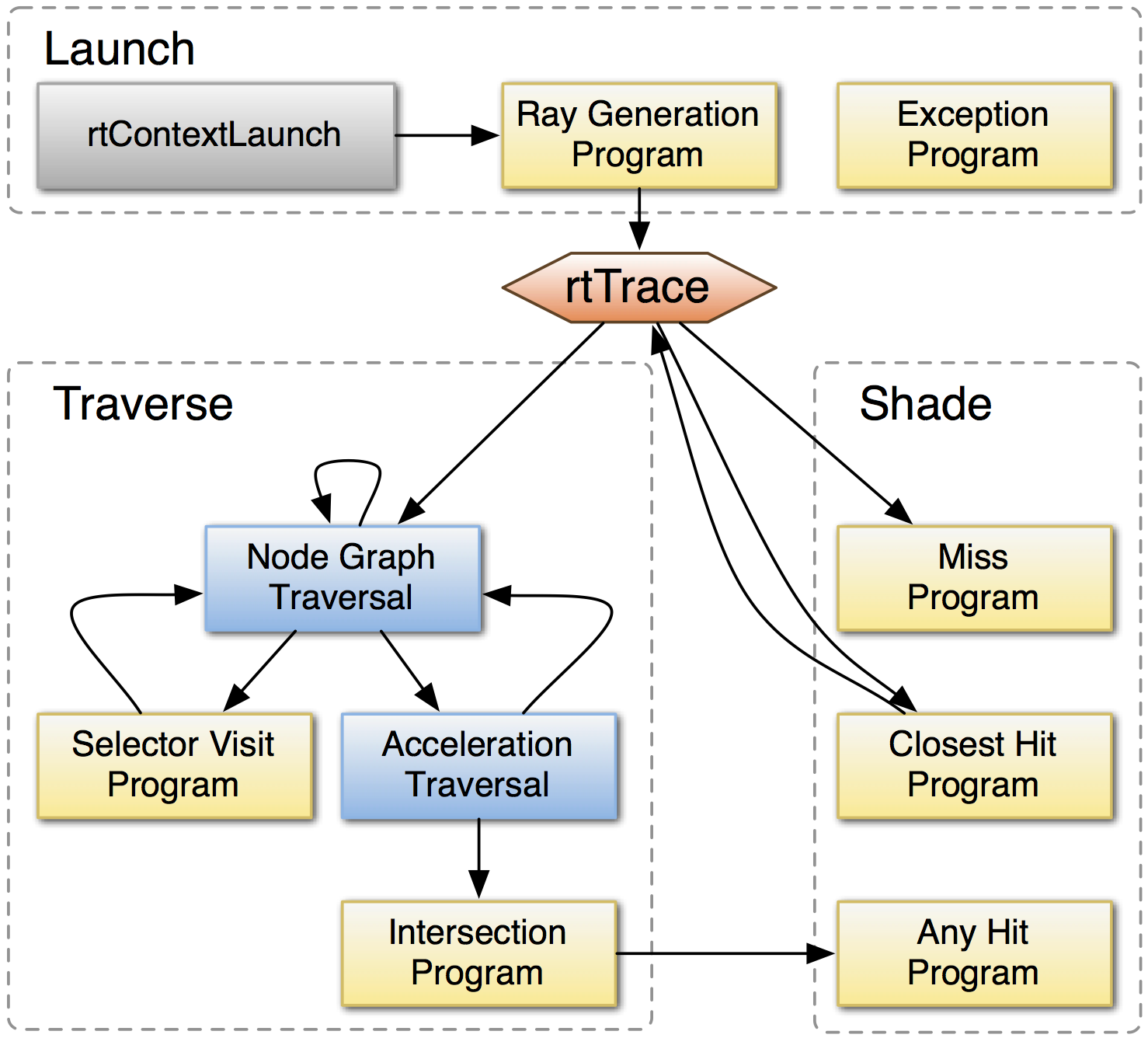
OptiX makes GPU ray tracing accessible
- accelerates ray-geometry intersections
- simple : single-ray programming model
- "...free to use within any application..."
- access RT Cores[1] with OptiX 6+ via RTX™ mode
NVIDIA expertise:
- OptiX pre-7 : ~linear scaling up to 4 GPUs
- acceleration structure creation + traversal (Blue)
- instanced sharing of geometry + acceleration structures
- compiler optimized for GPU ray tracing
https://developer.nvidia.com/rtx
User provides (Yellow):
- ray generation
- geometry bounding box, intersects
[1] Turing+ GPUs eg NVIDIA TITAN RTX
NVIDIA OptiX 7 : Entirely new thin API (Introduced Aug 2019)
GPU Ray Tracing APIs Converged
- 3 APIs (DXR,VKRay,OptiX7) over RTX
- Driver updates independent of application
- Support new GPUs, performance improvements
NVIDIA OptiX 6->7 : drastically slimmed down
- headers only (no library, just Driver)
- low-level CUDA-centric thin API (Vulkan-ized)
- Minimal host state, All host functions are thread-safe
- GPU launches : explicit, asynchronous (CUDA streams)
- near perfect scaling to 4 GPUs, for free
- Shared CPU/GPU geometry context
- GPU memory management
- Multi-GPU support
- Advantages
More control/flexibility over everything.
- Fully benefit from future GPUs
- Keep pace with state-of-the-art GPU ray tracing
- Disadvantages
Demands much more developer effort than OptiX 6
- Major re-implementation of Opticks required
LATEST: Opticks transition from 6->7 is ongoing
Geant4OpticksWorkflow
Geant4OpticksWorkflow 2
Integrate NVIDIA OptiX with Geant4
- Geometry Translation + "Gensteps"
- => entirely offload photon simulation to GPU
- upload translated geometry at initialization
- only hits need to consume CPU memory
Opticks : Translates G4 Optical Physics to CUDA/OptiX
GPU Resident Photons
- Seeded on GPU
- associate photons -> gensteps (via seed buffer)
- Generated on GPU, using genstep param:
- number of photons to generate
- start/end position of step
- Propagated on GPU
- Only photons hitting PMTs copied to CPU
Thrust: high level C++ access to CUDA

OptiX : single-ray programming model -> line-by-line translation
- CUDA Ports of Geant4 classes
- G4Cerenkov (only generation loop)
- G4Scintillation (only generation loop)
- G4OpAbsorption
- G4OpRayleigh
- G4OpBoundaryProcess (only a few surface types)
- Modify Cherenkov + Scintillation Processes
- collect genstep, copy to GPU for generation
- avoids copying millions of photons to GPU
- Scintillator Reemission
- fraction of bulk absorbed "reborn" within same thread
- wavelength generated by reemission texture lookup
- Opticks (OptiX/Thrust GPU interoperation)
- OptiX : upload gensteps
- Thrust : seeding, distribute genstep indices to photons
- OptiX : launch photon generation and propagation
- Thrust : pullback photons that hit PMTs
- Thrust : index photon step sequences (optional)
G4VSolid -> CUDA Intersect Functions for ~10 Primitives
- 3D parametric ray : ray(x,y,z;t) = rayOrigin + t * rayDirection
- implicit equation of primitive : f(x,y,z) = 0
- -> polynomial in t , roots: t > t_min -> intersection positions + surface normals
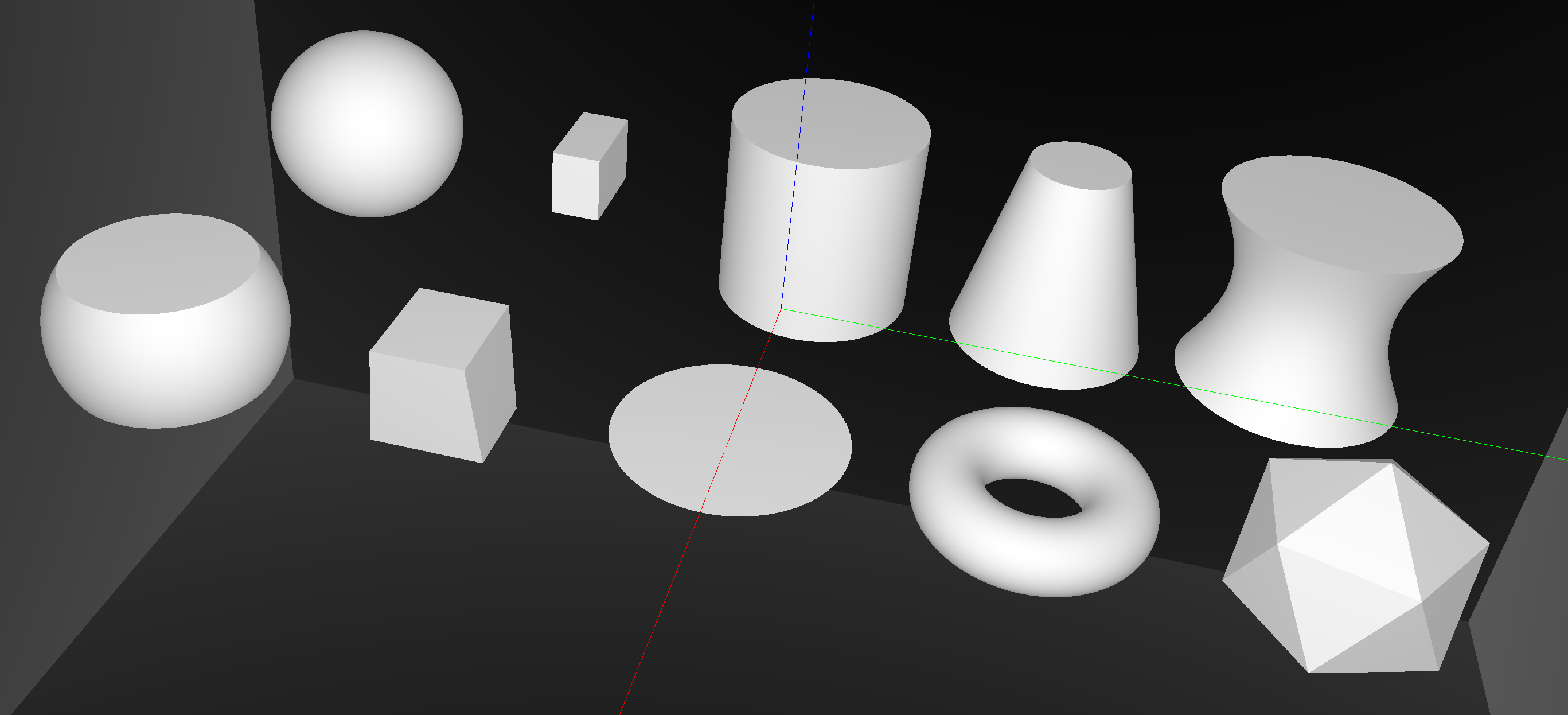
Sphere, Cylinder, Disc, Cone, Convex Polyhedron, Hyperboloid, Torus, ...
G4Boolean -> CUDA/OptiX Intersection Program Implementing CSG
Outside/Inside Unions
dot(normal,rayDir) -> Enter/Exit
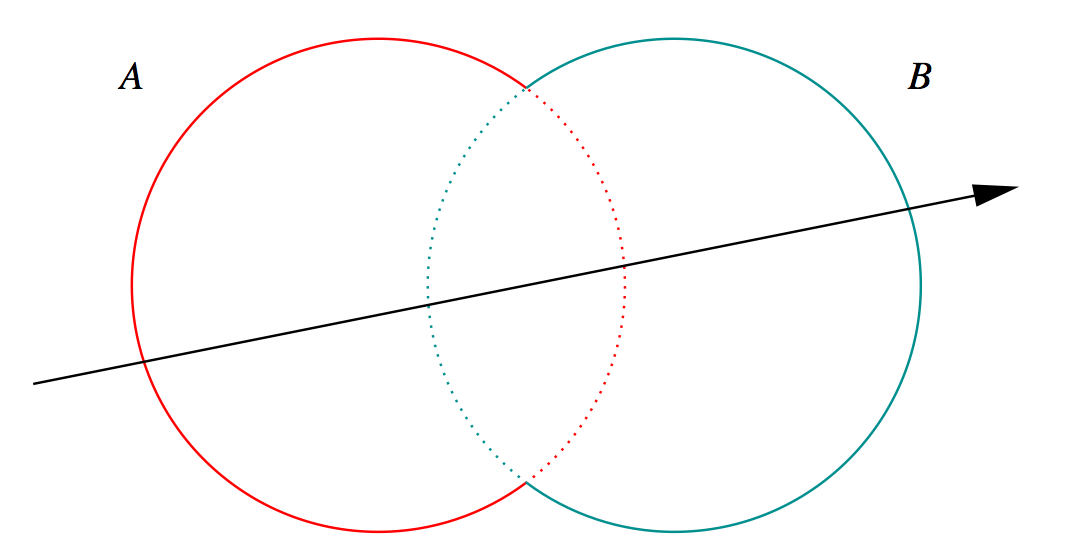

- A + B boundary not inside other
- A * B boundary inside other
Complete Binary Tree, pick between pairs of nearest intersects:
| UNION tA < tB | Enter B | Exit B | Miss B |
|---|---|---|---|
| Enter A | ReturnA | LoopA | ReturnA |
| Exit A | ReturnA | ReturnB | ReturnA |
| Miss A | ReturnB | ReturnB | ReturnMiss |
- Nearest hit intersect algorithm [1] avoids state
- sometimes Loop : advance t_min , re-intersect both
- classification shows if inside/outside
- Evaluative [2] implementation emulates recursion:
- recursion not allowed in OptiX intersect programs
- bit twiddle traversal of complete binary tree
- stacks of postorder slices and intersects
- Identical geometry to Geant4
- solving the same polynomials
- near perfect intersection match
- [1] Ray Tracing CSG Objects Using Single Hit Intersections, Andrew Kensler (2006)
- with corrections by author of XRT Raytracer http://xrt.wikidot.com/doc:csg
- [2] https://bitbucket.org/simoncblyth/opticks/src/tip/optixrap/cu/csg_intersect_boolean.h
- Similar to binary expression tree evaluation using postorder traverse.
Opticks : Translates G4 Geometry to GPU, Without Approximation
Materials/Surfaces -> GPU Texture
Material/Surface/Scintillator properties
- interpolated to standard wavelength domain
- interleaved into "boundary" texture
- "reemission" texture for wavelength generation
Material/surface boundary : 4 indices
- outer material (parent)
- outer surface (inward photons, parent -> self)
- inner surface (outward photons, self -> parent)
- inner material (self)
Primitives labelled with unique boundary index
- ray primitive intersection -> boundary index
- texture lookup -> material/surface properties
simple/fast properties + reemission wavelength
G4 Structure Tree -> Instance+Global Arrays -> OptiX
Group structure into repeated instances + global remainder:
- auto-identify repeated geometry with "progeny digests"
- JUNO : 9 distinct instances + 1 global
- instance transforms used in OptiX/OpenGL geometry
instancing -> huge memory savings for JUNO PMTs
Translation 1st Step : Geant4 -> Opticks/GGeo : 1->1 conversions
Geant4 -> Opticks/GGeo -> OptiX
Multi-stage translation
- Geant4
- G4PVPlacement, G4VSolid, G4Material, ...
- Opticks/GGeo : (No Geant4,OptiX dependency)
- GGeo, GVolume, GParts, GMesh, GMaterial, ... persisted as binary .npy file based geocache
- Opticks/OptiXRap (for OptiX < 7)
- OGeo, OScene, OGeometry, OBndLib, ... instanciation populates OptiX GPU context
- Opticks/CSG (for OptiX 7+)
- CSGFoundry, CSGSolid, CSGPrim, CSGNode replaces model dropped in 6->7
- OptiX
- "IAS", "GAS", ...
Structural volumes : G4PVPlacement ->
- GVolume
- JUNO: tree of ~300,000 GVolume
Solid shapes : G4VSolid ->
- GMesh (collected into GMeshLib)
- arrays: vertices, indicesref to NCSG
- NCSG
- tree of NNode (CSG constituents)
Material/surface properties as function of wavelength
- G4Material -> GMaterial
- G4Logical(Border/Skin)Surface -> GSurface
- adopts standard wavelength domain
- collected into GMaterialLib GSurfaceLib
Translation steered by X4 package
https://bitbucket.org/simoncblyth/opticks/src/master/extg4/X4PhysicalVolume.hh
Translation 2nd Step : Opticks/GGeo Instancing : "Factorizes" Geometry
Form of GPU Detector Geometry
- ~10 GAS
- intersect prog, bufs: bbox, nodes, transforms
- 1 IAS in OptiX 7, ~10 in pre-7
- transforms + refs: GAS, ident, boundary tex
- Boundary GPU Texture, interleaving:
- material + surface props
JUNO: ~300,000 GVolume -> ~10 GMergedMesh
- repeated GMergedMesh
- thousands of instance transformsconsolidates < 10 GVolume
- remainder GMergedMesh
- one identity instance transformconsolidates ~ few hundred GVolume
- Structural volumes vs solid shapes
- distinction for convenience only, distinction is movable
JUNO: ~300,000 GVolume : mostly small repeated groups (PMTs)
GGeo/GInstancer
- GVolume progeny digest : shapes+transforms -> subtree ident.
- find repeated digests, disqualifying repeats inside others
- label all nodes with repeat index, non-repeated remainder : 0
For each repeat+remainder create GMergedMesh:
- collecting transforms, identity -> instance arrays
- merged volumes+solids
- GMesh: concatenated arrays: triangles, indices
- GParts: concatenated arrays: CSG nodes + transforms
- transforms applied -> gets into instance frame
- Consolidation : structural volumes -> compound solid
GMergedMesh -> IAS+GAS
https://bitbucket.org/simoncblyth/opticks/src/master/ggeo/GInstancer.hh
"CSGFoundry" : Shared CPU/GPU Geometry Model (OptiX pre-7 & 7)
IAS < Inst < Solid < Prim < Node
- Inst : 4x4 tran. + Solid ref. ( Inst -> 1 IAS )
- Solid : 1 or more Prim : ( Solid -> GAS )
- Prim : 1,3,7,15,31,... Node : (Prim ~ G4VSolid)
struct CSGFoundry
{
void upload(); // to GPU
...
std::vector<CSGSolid> solid ; // compounds (eg PMT)
std::vector<CSGPrim> prim ;
std::vector<CSGNode> node ; // shapes, operators
std::vector<float4> plan ; // planes
std::vector<qat4> tran ; // CSG transforms
std::vector<qat4> itra ; // inverse CSG transforms
std::vector<qat4> inst ; // instance transforms
// entire geometry in four GPU allocations
CSGPrim* d_prim ;
CSGNode* d_node ;
float4* d_plan ;
qat4* d_itra ;
};
referencing by offset, count
- replaces geometry context dropped in OptiX 6->7
- array-based -> simple, inherent serialization + persisting
- entire geometry in 4 GPU allocations
- https://bitbucket.org/simoncblyth/opticks/src/master/CSG/
- CSGFoundry
- model, GPU upload
- csg_intersect_tree.h/csg_intersect_node.h/...
- simple headers common to pre-7/7/CPU-testing
- opticks/src/master/CSG_GGeo/
- Convert Opticks/GGeo -> CSGFoundry
- opticks/src/master/qudarap/
- Simulation excluding geometry, generation
- opticks/src/master/CSGOptiX/
- OptiX 7 + pre-7 geometry : depends on CSG, QUDARap
GAS : Geometry Acceleration Structure
IAS : Instance Acceleration Structure
CSG : Constructive Solid Geometry
Two-Level Hierarchy : Instance transforms (IAS) over Geometry (GAS)
OptiX supports multiple instance levels : IAS->IAS->GAS BUT: Simple two-level is faster : works in hardware RT Cores
- AS
- Acceleration Structure
- IAS (aka TLAS)
- 4x4 transforms, refs to GAS
- GAS (aka BLAS)
- custom primitives : AABBtriangles : vertices, indices
- AABB
- axis-aligned bounding box
SBT : Shader Binding Table
Flexibly binds together:
- geometry objects
- shader programs
- data for shader programs
Hidden in OptiX 1-6 APIs
Opticks Generality
Opticks Generality 2
General Geometry Translation
BUT: every new geometry likely to have problems
- Geant4 CSG
- "volume" based CSG in double precision
- Opticks CSG
surface based intersection in float precision
- more susceptible to coincident face issues
- "G4Boolean abuse" solids -> reduced performance
cxr_overview_emm_t0_moi_-1_ALL.jpg
JUNO Opticks OptiX 7 Ray-trace
"CSGFoundry" CPU/GPU Geometry
- purely analytic CSG, no triangles
- everything at default, no optimization
cxr_overview_emm_t0,_moi_-1.jpg
-e t0, : NOT 0 : 3084:sWorld : exclude global remainder volumes
cxr_overview_emm_image_grid_overview
- Comparison of ray traced render times of different geometry
- simple way to find issues, eg over complex CSG, overlarge BBox
sWaterTube_image_grid_cxr_view
- Same viewpoint inside JUNO Central Detector, vary included volumes
- ray trace performance very sensitive to geometry and its modelling => BVH structure
[Dec 2021] JUNO : OptiX 7 Ray Trace Times ~2M-pix : TITAN RTX
Same viewpoint, vary GPU geometry
- -e : controls components : "t" means ~ (NOT)
- time(s) : GPU ray trace CUDA launch time
- relative : compares to "ONLY PMT" baseline
Recent Geometry Fixes
- fix profligate PMT modelling
- simpler Acrylic fastener
- avoid overlarge Fastener BBox
- fix Polycone inner overlap
- Small-ish time range 1:15 (previously 1:600)
- suggests no bad bottlenecks remaining
Substantial speedup after fixing geometry issues
ALL PMTs : 0.0097 -> 0.0061 (x1.6 faster)
ALL : 0.6240 -> 0.0054 (x155 faster)
| idx | -e | time(s) | relative | enabled geometry description 3dbec4dc |
|---|---|---|---|---|
| 0 | 5, | 0.0004 | 0.0643 | ONLY: 1:sStrutBallhead |
| 1 | 9, | 0.0004 | 0.0658 | ONLY: 130:sPanel |
| 2 | 7, | 0.0005 | 0.0782 | ONLY: 1:base_steel |
| 3 | 8, | 0.0006 | 0.0966 | ONLY: 1:uni_acrylic1 |
| 4 | 6, | 0.0006 | 0.1009 | ONLY: 1:uni1 |
| 5 | 1, | 0.0009 | 0.1476 | ONLY: 5:PMT_3inch_pmt_solid FAST cf 20in |
| 6 | 4, | 0.0015 | 0.2386 | ONLY: 4:mask_PMT_20inch_vetosMask |
| 7 | 3, | 0.0033 | 0.5373 | ONLY: 5:HamamatsuR12860sMask SLOW cf 3in |
| 8 | 0, | 0.0040 | 0.6556 | ONLY: 3084:sWorld |
| 9 | 2, | 0.0040 | 0.6627 | ONLY: 5:NNVTMCPPMTsMask SLOW cf 3in |
| 10 | t4, | 0.0050 | 0.8307 | EXCL: 4:mask_PMT_20inch_vetosMask |
| 11 | t2, | 0.0051 | 0.8391 | EXCL: 5:NNVTMCPPMTsMask |
| 12 | t3, | 0.0052 | 0.8514 | EXCL: 5:HamamatsuR12860sMask |
| 13 | t6, | 0.0053 | 0.8799 | EXCL: 1:uni1 |
| 14 | t7, | 0.0054 | 0.8809 | EXCL: 1:base_steel |
| 15 | t0 | 0.0054 | 0.8843 | ALL |
| 16 | t5, | 0.0054 | 0.8843 | EXCL: 1:sStrutBallhead |
| 17 | t9, | 0.0054 | 0.8855 | EXCL: 130:sPanel |
| 18 | t1, | 0.0054 | 0.8860 | EXCL: 5:PMT_3inch_pmt_solid |
| 19 | t8, | 0.0055 | 0.9013 | EXCL: 1:uni_acrylic1 |
| 20 | t0, | 0.0059 | 0.9753 | EXCL: 3084:sWorld |
| 21 | 1,2,3,4 | 0.0061 | 1.0000 | ONLY PMT |
| 22 | t8,0 | 0.0062 | 1.0217 | EXCL: 1:uni_acrylic1 3084:sWorld |
Validation of Opticks Simulation by Comparison with Geant4
Random Aligned Bi-Simulation
Same inputs to Opticks and Geant4:
- CPU generated photons
- GPU generated randoms, fed to Geant4
Common recording into OpticksEvents:
- compressed photon step record, up to 16 steps
- persisted as NumPy arrays for python analysis
Aligned random consumption, direct comparison:
- ~every scatter, absorb, reflect, transmit at matched positions, times, polarization, wavlen
Bi-simulations of all JUNO solids, with millions of photons
- mis-aligned histories
- mostly < 0.25%, < 0.50% for largest solids
- deviant photons within matched history
- < 0.05% (500/1M)
Primary sources of problems
- grazing incidence, edge skimmers
- incidence at constituent solid boundaries
Primary cause : float vs double
Geant4 uses double everywhere, Opticks only sparingly (observed double costing 10x slowdown with RTX)
Conclude
- neatly oriented photons more prone to issues than realistic ones
- perfect "technical" matching not feasible
- instead shift validation to more realistic full detector "calibration" situation
scan-pf-check-GUI-TO-SC-BT5-SD
scan-pf-check-GUI-TO-BT5-SD
Performance : Scanning from 1M to 400M Photons
Test Hardware + Software
Workstation
- DELL Precision 7920T Workstation
- Intel Xeon Gold 5118, 2.3GHz, 48 cores, 62G
- NVIDIA Quadro RTX 8000 (48G)
Software
- Opticks 0.0.0 Alpha
- Geant4 10.4p2
- NVIDIA OptiX 6.5.0
- NVIDIA Driver 435.21
- CUDA 10.1
IHEP GPU Cluster
- 10 nodes of 8x NVIDIA Tesla GV100 (32G)
Full JUNO Analytic Geometry j1808v5
- "calibration source" genstep at center of scintillator
Production Mode : does the minimum
- only saves hits
- skips : genstep, photon, source, record, sequence, index, ..
- no Geant4 propagation (other than at 1M for extrapolation)
Multi-Event Running, Measure:
- interval
- avg time between successive launches, including overheads: (upload gensteps + launch + download hits)
- launch
- avg of 10 OptiX launches
- overheads < 10% beyond 20M photons
scan-pf-1_NHit
Photon Launch Size : VRAM Limited
NVIDIA Quadro RTX 8000 (48 GB)
- photon 4*4 floats : 64 bytes
- curandState : 48 bytes
400M photons x 112 bytes ~ 45G
scan-pf-1_Opticks_vs_Geant4 2
| JUNO analytic, 400M photons from center | Speedup | |
|---|---|---|
| Geant4 Extrap. | 95,600 s (26 hrs) | |
| Opticks RTX ON (i) | 58 s | 1650x |
scan-pf-1_Opticks_Speedup 2
| JUNO analytic, 400M photons from center | Speedup | |
|---|---|---|
| Opticks RTX ON (i) | 58s | 1650x |
| Opticks RTX OFF (i) | 275s | 350x |
| Geant4 Extrap. | 95,600s (26 hrs) | |
Useful Speedup > 1500x : But Why Not Giga Rays/s ? (1 Photon ~10 Rays)
100M photon RTX times, avg of 10
| Launch times for various geometries | |||
|---|---|---|---|
| Geometry | Launch (s) | Giga Rays/s | Relative to ana |
| JUNO ana | 13.2 | 0.07 | |
| JUNO tri.sw | 6.9 | 0.14 | 1.9x |
| JUNO tri.hw | 2.2 | 0.45 | 6.0x |
| Boxtest ana | 0.59 | 1.7 | |
| Boxtest tri.sw | 0.62 | 1.6 | |
| Boxtest tri.hw | 0.30 | 3.3 | 1.9x |
- ana : Opticks analytic CSG (SM)
- tri.sw : software triangle intersect (SM)
- tri.hw : hardware triangle intersect (RT)
JUNO 15k triangles, 132M without instancing
Simple Boxtest geometry gets into ballpark
- NVIDIA claim : 10 Giga Rays/s with RT Core
- -> 1 Billion photons per second
- RT cores : built-in triangle intersect + 1-level of instancing
- flatten scene model to avoid SM<->RT roundtrips ?
OptiX Performance Tools and Tricks, David Hart, NVIDIA https://developer.nvidia.com/siggraph/2019/video/sig915-vid
Overview + Links
Highlights
- Benefit from hardware accelerated ray tracing
- Opticks > 1500x Geant4 (one Turing GPU)

Opticks : state-of-the-art GPU ray tracing applied to optical photon simulation and integrated with Geant4, eliminating memory and time bottlenecks.

- ~30yrs/Giga-$ of HW+SW optimization applied to optical simulation
- Drastic speedup -> better detector understanding -> greater precision
- any simulation limited by optical photons can benefit
- more photon limited -> more overall speedup (99% -> 100x)

| https://bitbucket.org/simoncblyth/opticks | code repository |
| https://simoncblyth.bitbucket.io | presentations and videos |
| https://groups.io/g/opticks | forum/mailing list archive |
| email:opticks+subscribe@groups.io | subscribe to mailing list |
